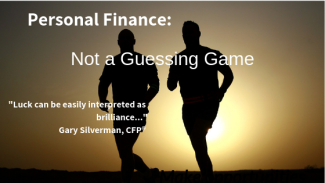
How Training for a Marathon is like Managing your Finances: Lesson Two
By Gary Silverman, CFP®
Let’s recap: I set a goal. I used the SMART method (Smart, Measurable, Achievable, Relevant, Time bound) to determine if it was a good goal. All looked okay, except perhaps it being achievable. I never did check to see if I could train enough in time for the event (a 14-mile run around the Wichita Falls Circle Trail). I just guessed I could. Once I said that I was going to do it, I began transforming justifications into reasons to believe my guessing.
Being the brilliant (and humble) person I am, I did realize that I was not going about this in the right way. However, I justified it by thinking that if I was getting tired or sore, I could walk a bit. I determined that intermittent walking should still allow me to finish before the event was over. Besides, there would be sponsored rest stops about every mile. My justification turned to confidence.
The problem was, I started this goal coming off an injury. I had aggravated something called an IT-band (it makes the area around your knee hurt) and then had run a 10K (6.2 miles) before it had fully healed. That delayed when I could get back to running and slowed my training. Did I adjust my training plan? No, since I didn’t have a training plan other than to run a bit longer each week. Did I adjust my goal? No. The city wasn’t going to change when the event or how long the trail was just because I was behind in training. Did I examine the possibility that the goal was unachievable? No.
Ostriches don’t bury their heads in the sand, but I sure did.
My non-plan seemed to be going smoothly. Training runs were going well. I was still doing the occasional 5K (3.1 mile) race and winning medals. My tendon wasn’t inflamed any more. I had my long-run mileage up to 9 miles. I figured that was enough. Again, “figured” meant “guessed.” Generally, you want to get your long training runs close to the distance you are training for.
For a 14-mile run, I’d want to have gotten to at least 11 miles, preferably all the way to 15. Even you non-mathematicians will notice that all these numbers are bigger than nine miles. Sadly, I knew all of this. But if you remember from last week, I had once accidentally run eight miles…over twice the distance I normally ran. So, if I could run eight miles when I normally ran three miles, how hard could it be running 14 when I was trained up to nine?
It is easy to misconstrue a one-time event that was successful mostly due to luck from some great ability. When it comes to investing, I have found that the bigger mistakes are made by people who had a big win at first. Luck can be easily interpreted as brilliance.
Gary Silverman, CFP® is the founder of Personal Money Planning, LLC, a Wichita Falls retirement planning and investment management firm and author of Real World Investing

